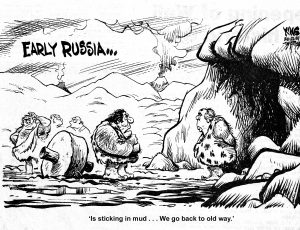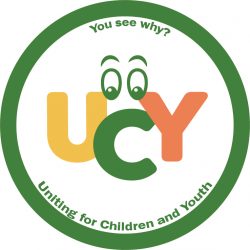If you want to control, you design organizations for accountability.
If you want to accomplish, you design for commitment.
– Tapscott and Caston, Paradigm Shift

Change is happening like never before, and according to John Petersen, futurist of the Arlington Institute, we can only make the best of it by thinking outside the box. Ken Robinson expresses a similar view in his video Changing Education Paradigms.
From the study of paradigm shifts, much has been learned that we need to apply to education. When a dominant paradigm is proving to be inadequate despite the protracted efforts of its most able disciples to solve its problems, other paradigms emerge in a battle to replace it, and proponents of the dominant paradigm will do what they can to keep contenders at bay.
It has been found that it is generally the young and the new who usher in a new paradigm, and it is easy to understand why. The people in charge of the old education paradigm are its successful products. It has worked for them and they consequently believe it can work for everyone. For them to adopt a new paradigm, they need to go through a painful process of acknowledging that much of what they have conscientiously spent their careers doing has not served students as well as once thought. We can certainly feel compassion for those caught in this dilemma, but we must not let it diminish our commitment to students and a just society.
Some disciples of dominant paradigms that are proving to be inadequate are relatively quick to recognize the benefits of a new paradigm, others take longer, and some never get outside their box. It stands to reason that those slowest to change are those who have been longest in the old paradigm and who have reached its highest ranks. In other words, the people most in control of our old school systems are possibly the ones most unlikely to lead the transition to a better paradigm. Various sayings exist that make this point. We’ve all heard it said that science progresses when old scientists die. Marshall McLuhan said we don’t know who discovered water, but we know it wasn’t the fish, meaning that if all we really know is what we swim in everyday, we likely have no idea that there are fresher waters elsewhere. It has also been said that the worst people to clean up a mess are the ones who created it. The message is that the people in charge of education today are not the ones we should expect to lead a transition to a better model.
John Gatto in his book Dumbing Us Down wrote, “It is the great triumph of compulsory government monopoly mass-schooling that among even the best of my fellow teachers, and among even the best of my students’ parents, only a small number can imagine a different way to do things.” It alludes to the competition between paradigms, but it doesn’t mean that proponents of an old paradigm are necessarily oblivious to a different way of doing things. In the 16th century for example, people knew of Copernicus’s theories, but rejected them believing that if the earth moved at the speed he said it did, then when people jumped into the air the earth would move out from under them before they came down. There is plenty of evidence that today’s education leaders know that the democratic learning model is a contender to replace the dominant Prussian model, but they simply don’t get how students can be responsible for their own learning and equal partners in decisions that affect them. The misconception is similar to the one women have had to battle. People once said in all earnestness that women could never operate effectively in the boardrooms of big business. It’s all about opportunity. Given the chance to prove themselves, they proved that they were perfectly capable. When students are given a proper chance to direct their learning, they demonstrate not only that adults can trust them with the task, but also that we err if they are not given that responsibility.
Before leaving the arguments that question the ability of today’s education leaders to fix what many call a broken system, consider the following quote.
“Today, on every side, however, there is heard a growing demand for a fresh look at education in Ontario. The Committee was told of inflexible programs, outdated curricula, unrealistic regulations, regimented organization, and mistaken aims of education. We heard from alienated students, frustrated teachers, irate parents, and concerned educators. Many public organizations and private individuals have told us of their growing discontent and lack of confidence in a school system which, in their opinion, has become outmoded and is failing those it exists to serve.”
This is a statement found in Living and Learning, the ground shaking report published by the Ontario Government in 1968 when Bill Davis was the education minister. For many observers, it rings as true today as it did fifty years ago, and their view is supported by the 2018 survey of public opinion on schools, conducted by professors Doug Hart and Arlo Kempf of the Ontario Institute for Studies in Education. They found that only “Half of the public are somewhat or very satisfied with the school system in general.” We all know how easy it is to find people who are discontented with pubic education, but the survey puts a number on it. Fifty percent of those surveyed are less than satisfied, and a closer look might reveal that a large number of those who say they are satisfied are saying it for the wrong reasons. Students who appear to be well served by the system are often overstressed pleasers obsessed with achieving personal success. They appear to be well off because they are on track to get into colleges and universities, but real success is about much more. It requires knowing yourself and it is only genuine when everyone is succeeding in a climate of well-being. The current system gives lip service to this, but it doesn’t deliver.
For half a century, and actually much more, talented educators have applied themselves to solving the problems of public education, yet the problems persist because they are working from the perspective of the old paradigm. For evidence of this consider that the only tangible result of the OCDSB’s five year study of its secondary school program was to create a second International Baccalaureate program for students on the west side of town. A forward looking document created by the board, Unleashing Potential, Harnessing Possibilities, was prominent at the time, yet the best the board was able to do was to provide more of the same. The leaders consulted the public, but they interpreted what was workable or not workable through their own lenses.
The Copernican Revolution was not like the paradigm shift being called for in education. It was all or none. Either you believed the earth was the center of the universe, or you didn’t, but this kind of flip-flop is not required with the democratic revolution in education. Schools can become democratic incrementally. Each small step towards non-coercive learning environments can be studied to determine the next best step. Through this process it might be discovered that our best option is something a little more controlled than the best known totally non-coercive Sudbury Valley School. The challenge confronting educators and their communities today is to embark on the discovery process of determining if and where the ideal may fall between coercive and non-coercive learning environments, and not to settle for better until it becomes clearly the best.
The current school authorities, described above as perhaps not the best to implement fundamental change, remain essential for what they know about their systems. An incremental transition to a new paradigm requires people who have a deep knowledge of how school boards operate. A transition left to the futurists risks a backlash that sends everyone scurrying back to the old way of doing things, as the above Alan King cartoon portrays. A paradigm shift in education will occur most effectively if we apply the lessons learned from previous paradigm shifts and we don’t let it become a destructive competition. We need it to occur as a constructive collaboration between opposing views in order to find with the least possible disruption the best solution for students and the world they are inheriting. The grounded theory approach to change mentioned on the UCY homepage is a way to approach change when the end result is not fully known.
The short video with Peter Senge and Justin Reich that was also mentioned on the UCY homepage helps to create the vision of how to invite real change.


One Reply to “A Need for Systemic Innovation Advisory Committees”
Comments are closed.